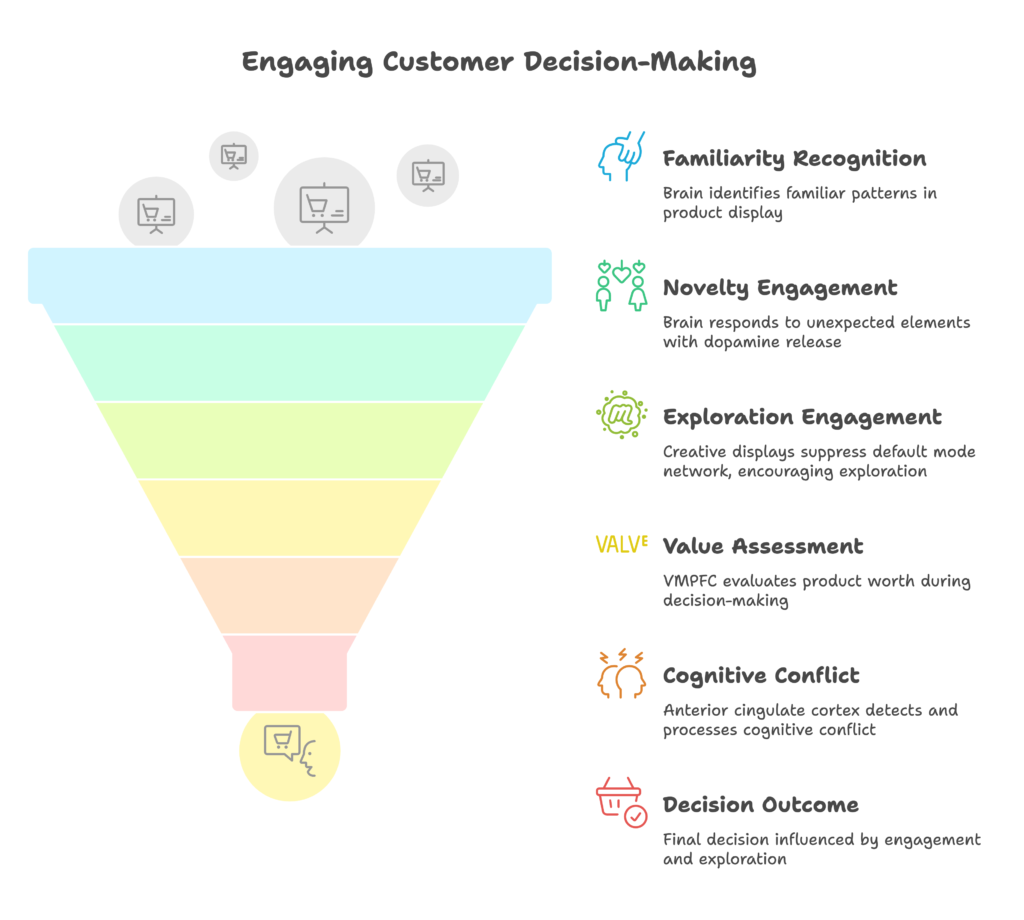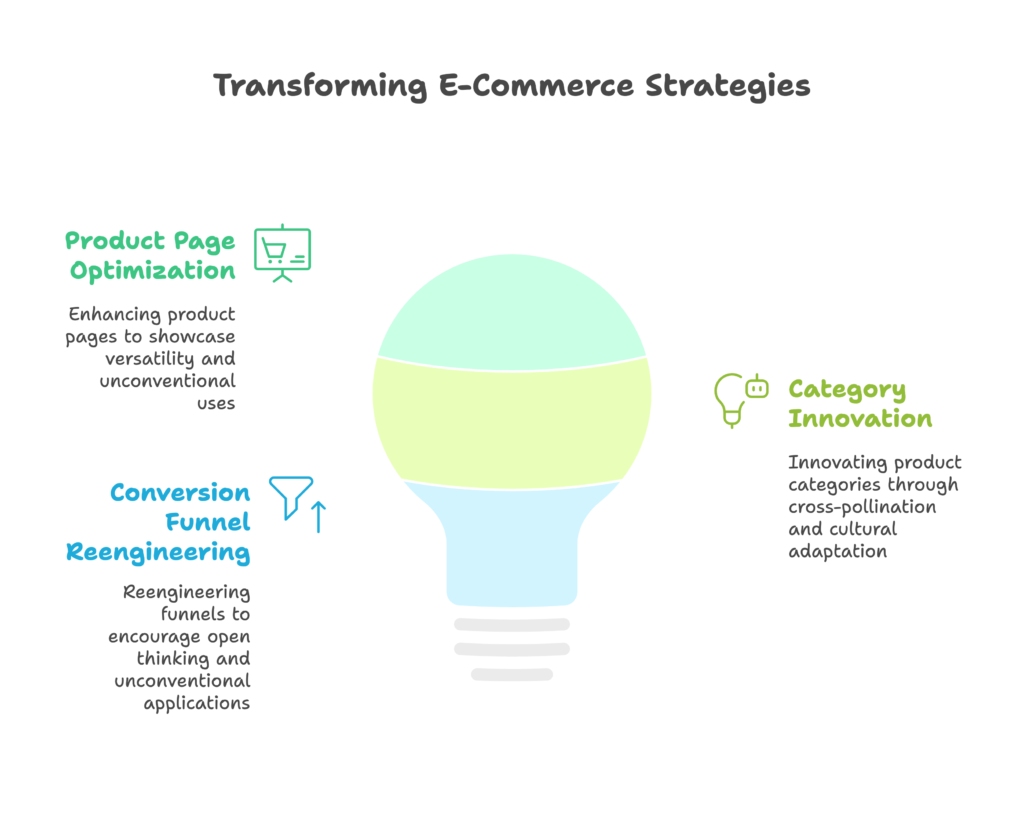Have you ever looked at a product online and thought, “That’s just not for me” without really knowing why? Or perhaps you’ve struggled to see how a product could solve your specific problem, even though it’s perfectly capable? If so, you’ve experienced functional fixedness – a cognitive bias that limits our ability to see objects as anything other than their common use.
This mental barrier doesn’t just affect you as a consumer; if you’re running an online store, it could be secretly sabotaging your sales. The way you present your products might be unintentionally trapping potential customers in rigid thinking patterns!
In this article, you’ll discover:
- Why our brains get “stuck” seeing products in only one way
- How this psychological phenomenon impacts buying decisions
- Practical strategies to break through this mental barrier in your product presentations
- Real-world success stories from brands that have mastered this technique
Ready to unlock a whole new dimension of product presentation that could dramatically boost your conversion rates? Let’s dive in!
The Psychology of Functional Fixedness
Let’s start by understanding what’s happening in your customers’ minds when they view your products. Functional fixedness is like wearing blinders – it prevents people from seeing creative uses for familiar objects. But why does this happen in the first place?
Cognitive Foundations
Functional fixedness was first identified by Gestalt psychologist Karl Duncker in 1945. He discovered that once we learn an object’s conventional purpose, our brains tend to “lock in” that understanding, making it surprisingly difficult to see alternative uses.
This mental constraint has clear neural roots. Our prefrontal cortex – responsible for executive function and decision-making – can become rigid in its categorization, while the hippocampus, which helps with flexible thinking, gets overshadowed. Interestingly, young children (around age 5) don’t yet exhibit functional fixedness, but by age 7, this cognitive limitation begins to emerge as their brains develop more fixed patterns.
Think about how many times you’ve passed over a product simply because you couldn’t immediately see how it fit into your life. That’s not your fault – it’s your brain’s efficiency systems at work!
Evolutionary Origins
This cognitive limitation didn’t develop to frustrate e-commerce store owners. It actually served an important evolutionary purpose. Categorical thinking – rapidly identifying objects and their standard uses – offered significant survival advantages for our ancestors. When you needed to quickly recognize a tool for defense or food gathering, rigid categorization helped speed up decisions.
But here’s where things get interesting: in today’s innovation-driven economy, this once-helpful trait has become a mismatch. The modern marketplace rewards creative thinking and novel applications, yet our brains still default to these ancient categorical constraints.
Even worse, our current product category systems in retail and digital commerce reinforce these limitations. When products are organized into strict categories with standardized descriptions, it only strengthens our tendency toward functional fixedness.
Impact on Consumer Perception
This cognitive bias has profound effects on how customers perceive your products. Consider how Starbucks strategically removed “Coffee” from their branding – they recognized that being categorized solely as a coffee company limited consumer perception of what they could offer.
Search algorithms further complicate this problem. When customers search for products based on conventional categories, they may never discover items that could serve their needs in unexpected ways. The cross-channel consistency that’s often praised in omnichannel retail can paradoxically reinforce functional fixedness by presenting products in identical, conventional ways across all touchpoints.
Now that we understand the psychological forces at work, you might be wondering: what’s happening at a deeper neural level when people encounter your products? Let’s explore the fascinating neuroscience behind product perception.
Neuroscience of Product Perception
When a potential customer lands on your product page, an intricate neural dance begins. Understanding this process gives you powerful insights into how to present your products more effectively. Let’s peek inside the brain!

Neural Encoding of Familiarity
The amygdala – often associated with emotional responses – plays a key role in how we process familiar product presentations. Conventional product displays trigger predictable activation patterns that feel safe and comfortable but don’t necessarily engage deeper interest.
However, when consumers encounter novel configurations or unexpected product presentations, something magical happens: the brain releases dopamine, the neurotransmitter associated with pleasure and reward. This dopamine response can create positive associations with your product and brand.
Even more fascinating is what happens in the default mode network – a brain system active when we’re not focused on the external world. Creative product presentations can actually suppress this network, pulling customers into a state of engaged exploration rather than passive browsing.
Decision-Making Pathways
As customers consider your products, specific brain regions drive their purchasing decisions. The ventromedial prefrontal cortex (VMPFC) becomes active during value assessment – it’s essentially calculating “Is this worth it to me?”
When your product presentation challenges conventional categories, the anterior cingulate cortex detects this cognitive conflict. Though this might sound negative, this “productive confusion” can actually lead to deeper processing and consideration – exactly what you want shoppers to do with your products!
The insula, meanwhile, responds to presentation incongruity. When something doesn’t quite match our expectations, this brain region perks up. Skillfully managed incongruity can spark curiosity rather than rejection.
Habituation vs. Innovation
Our brains love efficiency. Routine processing of familiar product presentations requires minimal cognitive resources – it’s easy and comfortable. But this neural efficiency comes at a cost: reduced attention and engagement.
There’s a delicate balance at play. Too much novelty creates cognitive overload, triggering rejection. But just the right amount of innovation in how you present products can engage the brain’s natural neuroplasticity – its ability to form new connections and ways of thinking.
The key is finding that sweet spot where your product presentations are novel enough to capture attention but not so radical that they exceed cognitive load thresholds.
Now that we’ve explored the fascinating neural underpinnings of functional fixedness, let’s get practical. How can we apply these insights to break through this cognitive barrier in digital commerce?
Breaking Fixedness in Digital Commerce
Here’s where we transform theory into action. With a solid understanding of the psychology and neuroscience behind functional fixedness, we can now implement specific strategies to overcome this limitation in your online store. Let’s explore some practical approaches!
Interface Design Strategies
Smart interface design can significantly reduce functional fixedness. One powerful approach is implementing the Generic Parts Technique – breaking products down into their component parts and highlighting how each component can serve multiple functions.
For example, rather than presenting a blender as simply “a blender,” your product description might highlight the precision-engineered blades (which can handle everything from ice to nuts), the variable speed control (perfect for both rough chopping and fine pureeing), and the detachable container (doubles as a storage solution).
Neutral labeling protocols can also help. Instead of using conventional category labels that reinforce functional fixedness, consider more open-ended descriptions that invite mental exploration.
Dynamic presentation architectures – where product displays change based on user behavior – can further combat rigid thinking. AI-driven contextual adaptation takes this even further by customizing how products are presented based on individual user contexts and behaviors.
Cognitive Flexibility Engineering
Progressive disclosure patterns can effectively counter functional fixedness. Instead of revealing all product information at once, strategically unfold details in a way that first establishes unconventional use cases before diving into specifications.
Multisensory presentation layering – combining visuals, text, and perhaps audio or video – creates multiple pathways for understanding a product beyond its conventional use. When different senses receive information about a product, they can bypass the usual cognitive shortcuts that lead to functional fixedness.
Gamified exploration interfaces turn product discovery into an engaging experience. By encouraging playful interaction with product features, these interfaces naturally lead users to discover new applications and uses they might otherwise miss.
Platform-Specific Solutions
If you’re using Shopify, you can leverage theme customization to create more flexible product presentations. Custom sections and dynamic templates can showcase products in ways that highlight versatility and multiple use cases.
For brands with the resources, AR/VR showrooms offer powerful tools for breaking functional fixedness. By allowing customers to virtually place products in different environments or interact with them in various scenarios, these technologies naturally encourage seeing beyond conventional uses.
AI-powered product storytelling engines represent the cutting edge in this space. These systems can generate contextually relevant narratives about your products that highlight non-obvious applications and benefits, dynamically adapting to individual users.
With these interface and presentation strategies in your toolkit, you’re ready to implement more sophisticated frameworks specifically designed for e-commerce. Let’s explore these next!
Strategic Frameworks for E-Commerce
Now let’s dive into comprehensive strategic frameworks that can transform how you present products across your entire e-commerce operation. These systematic approaches will help you consistently break through functional fixedness at every customer touchpoint.

Product Page Optimization
Feature recombination matrices offer a structured approach to showcasing product versatility. This involves creating a grid where product features are cross-referenced with various use cases or scenarios, highlighting unexpected combinations. For each intersection, you develop specific content that illustrates how that feature serves that particular use case.
Contextual analogy systems connect your product to familiar concepts from different domains. Statements like “This hammer works like a third hand when you’re trying to…” help customers make mental leaps to new applications. These analogies create cognitive bridges to new understanding.
Behavioral priming through microcopy – those small bits of text throughout your product pages – can subtly guide customers toward more flexible thinking. Phrases like “Also perfect for…” or “Unexpected uses include…” can open mental doors to seeing beyond conventional applications.
Category Innovation Playbook
Cross-category pollination brings insights from one product category to another. For example, applying organizational concepts from kitchen products to office supplies can create fresh perspectives that bypass functional fixedness.
Temporal presentation sequencing strategically unfolds product information over time. Rather than showing everything at once, this approach gradually reveals different aspects of a product, preventing premature categorization and the functional fixedness that comes with it.
For global markets, cultural override protocols acknowledge that functional fixedness is partly culturally determined. What seems like an obvious use in one culture may be non-obvious in another. Tailoring your presentation to account for these cultural differences can unlock new perceptions.
Conversion Funnel Reengineering
Curiosity-driven top-funnel presentation focuses on sparking interest through unexpected questions or scenarios rather than immediate product categorization. By leading with curiosity rather than classification, you encourage more open thinking from the start.
Mid-funnel flexibility triggers introduce alternative uses and applications just as customers are deepening their engagement with your products. This timing capitalizes on their already-engaged state to expand their perception of what your product can do.
Bottom-funnel justification scaffolding provides supporting evidence and social proof for non-obvious applications just as customers are making their final decision. This addresses any lingering doubts about unconventional uses at the critical moment of purchase decision.
With these strategic frameworks in place, you’ll need to measure their effectiveness and continuously optimize. Let’s explore how to track and improve your efforts to overcome functional fixedness.
Measurement & Optimization
How do you know if your strategies to overcome functional fixedness are actually working? This section explores sophisticated approaches to measuring effectiveness and optimizing your product presentations based on real data.
Neurometric Tracking
Advanced e-commerce operations are increasingly using neurometric tools to assess how customers perceive products. EEG coherence scores can measure brain activity during product exploration, revealing when customers experience those “aha!” moments that indicate they’ve broken through functional fixedness.
Eye-tracking heatmaps show which elements of unconventional product presentations draw attention and which go unnoticed. This data helps refine your approach to ensure key flexibility-promoting elements get proper attention.
Facial coding technology can detect micro-expressions indicating surprise or insight – valuable signals that your presentation has successfully challenged functional fixedness. These subtle facial responses often reveal more than what customers consciously report.
Behavioral Analytics
For most businesses, behavioral analytics provide more accessible measurement options. The Flexibility Adoption Rate (FAR) metric tracks the percentage of customers who engage with content about non-obvious product uses or purchase products after viewing such content.
Dwell time on recombinant features – how long customers spend exploring content about alternative uses – can indicate engagement with flexible thinking. Longer engagement typically suggests successful disruption of functional fixedness.
Cross-category click-through patterns reveal when customers are making connections between traditionally separate product categories. These patterns suggest your strategies are successfully promoting more flexible thinking about your products.
Machine Learning Applications
Predictive flexibility modeling uses machine learning to identify which customers are most likely to benefit from approaches that counter functional fixedness. These models can help you target your efforts where they’ll have the greatest impact.
Real-time presentation adaptation engines dynamically adjust how products are presented based on individual interaction patterns. As these systems learn what approaches work best for different customer segments, they continuously improve at countering functional fixedness.
Churn prediction through fixedness scoring can identify when limited product perception is contributing to customer attrition. By spotting these patterns early, you can intervene with strategies that expand product perception before customers leave.
Now that we have ways to measure our efforts, let’s explore some inspiring real-world examples of companies that have successfully broken through functional fixedness.
Case Studies in Presentation Innovation
Theory and strategies are valuable, but seeing real-world applications brings everything into sharper focus. These case studies show how innovative companies have successfully overcome functional fixedness to achieve remarkable results.
Dyson: From Vacuum to Airblade
Dyson masterfully broke through functional fixedness by applying their expertise in air movement technology across seemingly unrelated product categories. Their journey from vacuum cleaners to hand dryers, fans, and hair care tools demonstrates the power of component repurposing strategies.
Rather than presenting themselves as simply a “vacuum company,” Dyson reframed their identity around their core technology – cyclonic separation and efficient airflow engineering. This allowed customers to see beyond the conventional categorization.
Their multifunctional demonstration protocols showcase how the same underlying technology solves different problems across various contexts. This approach yielded impressive results: a 142% increase in cross-category sales as customers began to recognize Dyson’s expertise beyond a single product type.
IKEA Augmented Reality
IKEA’s AR application tackles functional fixedness by helping customers visualize furniture in their own spaces – a context that’s personally meaningful rather than the artificial showroom environment.
Their approach emphasizes contextual flexibility in room visualization, allowing customers to see how the same piece might function differently in various home settings. This helps break the single-use perception that often limits furniture purchases.
IKEA further enhances flexibility by encouraging user-generated configuration sharing. When customers see how others use the same products in unexpected ways, it naturally expands their perception of possibilities.
The results speak for themselves: a 37% reduction in returns, indicating that customers developed more accurate and flexible mental models of how products would function in their homes before purchasing.
Glossier’s Product Ecosystem
Beauty brand Glossier has built a devoted following by challenging functional fixedness in cosmetics. Their beauty tool recombination strategies emphasize how products can be mixed, layered, and repurposed rather than used in isolation for a single defined purpose.
Rather than dictating specific uses, Glossier employs community-driven use case crowdsourcing, allowing customers to share their own creative applications. This approach naturally counters functional fixedness by showcasing the same product being used in dozens of ways.
The strategy has yielded a 63% higher customer lifetime value compared to industry averages. When customers discover multiple uses for products, they find more value in them and develop deeper brand loyalty.
These inspiring examples show what’s possible when companies intentionally work to overcome functional fixedness. But this approach also raises important ethical considerations, which we’ll explore next.
Ethical Considerations
As we explore ways to overcome functional fixedness, we must also consider the ethical implications. Breaking through cognitive limitations should empower customers, not manipulate or confuse them. Let’s examine the responsible application of these techniques.
Dark Pattern Risks
There’s an important distinction between beneficial flexibility and intentional confusion. Tactics that deliberately mislead customers about a product’s core functionality cross an ethical line, even if they technically “break” functional fixedness.
This concern is particularly important for financial products, where clear understanding is essential. Vulnerability protection standards should guide how we present complex products to ensure that expanding perceived functionality doesn’t obscure critical limitations or risks.
Cognitive overload prevention is another ethical consideration. While some cognitive challenge is beneficial for breaking through functional fixedness, overwhelming customers with too many possibilities can lead to decision paralysis and frustration.
Transparency Protocols
Ethical approaches to overcoming functional fixedness include use case justification documentation. When presenting non-obvious applications, provide clear evidence and explanation for why these uses are valid and valuable.
Consider implementing neural impact disclosures for particularly novel presentations. Acknowledging when you’re intentionally challenging conventional thinking shows respect for customer autonomy and builds trust.
Cultural sensitivity auditing frameworks help ensure that efforts to overcome functional fixedness are appropriate across different cultural contexts. What might be an acceptable cognitive challenge in one culture could be confusing or off-putting in another.
Sustainability Integration
Breaking functional fixedness offers unique opportunities to promote sustainability. Circular economy presentation strategies highlight how products can be reused, repurposed, or recycled beyond their primary function.
Longevity-focused configuration education teaches customers how to adapt products for different uses as their needs change over time, extending product lifespan and reducing waste.
Waste reduction through multifunctional positioning emphasizes how single products that serve multiple functions can replace several single-use items, supporting more sustainable consumption patterns.
With ethical considerations in mind, let’s look toward the future of flexible product presentation. What emerging technologies and approaches will shape this field in the coming years?
Future of Flexible Presentation
The landscape of product presentation continues to evolve at a rapid pace. Understanding emerging trends can help you stay ahead of the curve in combating functional fixedness. Let’s explore what the future holds.
Emerging Technologies
Neural interface customization represents the frontier of personalized product presentation. Early research suggests that direct brain-computer interfaces could eventually allow for product presentations tailored to individual neural patterns, bypassing functional fixedness at its source.
Quantum computing configuration modeling promises to dramatically expand our ability to predict how different product presentations will affect cognitive processing. These advanced models could simulate countless presentation variations to identify those most likely to overcome functional fixedness for specific customer segments.
Self-optimizing product displays that continuously adjust based on real-time neural and behavioral feedback are already in early development. These systems could dynamically shift presentation elements to counter functional fixedness as it emerges during the shopping experience.
Predictive Systems
Genetic algorithm presentation engines mimic evolutionary processes to develop increasingly effective ways of presenting products. By generating, testing, and refining countless presentation variations, these systems can discover novel approaches to overcoming functional fixedness that human designers might never conceive.
Cross-platform consistency AI ensures coherent yet flexible product presentation across different channels and devices. These systems maintain brand identity while adapting presentations to leverage the unique capabilities of each platform to counter functional fixedness.
Emotion-adaptive interface systems detect subtle emotional responses to product presentations and adjust accordingly. When they sense frustration or confusion stemming from functional fixedness, they can shift presentation elements to promote more flexible thinking.
Global Standardization
As these approaches mature, we’re beginning to see efforts toward ISO standards for cognitive-friendly presentation. These emerging standards aim to establish best practices that promote flexible thinking while ensuring clarity and usability.
Cross-cultural flexibility indices are being developed to measure how effectively product presentations work across different cultural contexts. These tools will help global brands tailor their approach to overcoming functional fixedness in diverse markets.
Neuroethics certification programs focused on responsible cognitive engagement are gaining traction. These initiatives seek to establish guidelines for when and how it’s appropriate to challenge cognitive biases like functional fixedness in commercial contexts.
A Final Note for Shopify Store Owners: Ready to put these insights into action? Growth Suite Shopify app offers powerful tools to implement flexible product presentations that overcome functional fixedness and boost your conversion rates. With customizable templates, AI-driven recommendations, and advanced analytics, you can start breaking through these cognitive barriers today.
References
- Wikipedia Contributors. (2025). Functional fixedness. Retrieved from https://en.wikipedia.org/wiki/Functional_fixedness
- Gracilla, N. (2025). Overcoming Functional Fixedness. Nick Gracilla Blog. https://www.nickgracilla.com/posts/overcoming-functional-fixedness/
- Schachter, T. (2022). How To Overcome Functional Fixedness. LinkedIn. https://www.linkedin.com/pulse/you-able-grow-its-your-consumers-fault-how-unfix-them-ted-schachter
- Paddle Team. (2025). Product Innovation Strategy. https://www.paddle.com/resources/product-innovation
- TGC Search. (2024). Overcoming Functional Fixedness. https://tgcsearch.com/business-insights/overcoming-functional-fixedness/
- Fortitude Business. (2022). Functional Fixedness in Creativity. https://fortitudebusinessconsulting.com.au/functional-fixedness-and-negative-judgements-destroy-creativity/
- Healthline. (2021). Functional Fixedness Explained. https://www.healthline.com/health/mental-health/functional-fixedness
- Kuder Consulting. (2023). Overcoming Functional Fixedness. YouTube. https://www.youtube.com/watch?v=RxVrMhLdQu8
- Skillicorn, N. (2021). Functional Fixedness Bias. Idea to Value. https://www.ideatovalue.com/crea/nickskillicorn/2021/08/functional-fixedness-bias-and-how-to-overcome-it/




